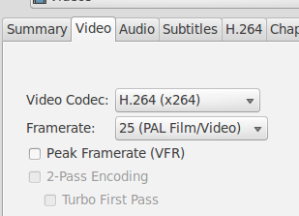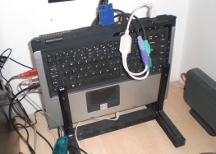I’ve decided to start a new blog with a more generic name as I am beginning to move away from Ubuntu to other distributions and want to write about my experiments without them being tagged to an Ubuntu blog. My new blog is here, Martin Cooper’s Linux Blog
New Blog
31, August 2011Amazon MP3 Downloader for Linux
6, August 2011I’ve just come across a site called textbookstuff that does DRM free audiobooks in MP3 format, these are limited to out of copy write books and poems and they are new so only have a few available at the moment. The difference is the books are read by well known reader but are produced with sound effects and music which make them more like a BBC play. They provide their book through various download options but the prices vary quite widely, the one I looked at downloading cost between £4.99 and £9.99 dependant which option you chose, the cheapest being Amazon which immediately caused me a problem as I wanting to use a Linux solution however the Linux solutions provided by Amazon failed to work due to dependency issues and also no 64bit support. This was solved by a little program called pymazon found here this worked for me in both Ubuntu 11.04 and Linux Mint Debian Edition both running XFCE . To install it from a Terminal just run the following commands;
$ sudo apt-get install python-crypto
$ sudo apt-get install python-qt4
$ wget http://pymazon.googlecode.com/files/Pymazon-0.9.tar.gz
$ tar -xzf Pymazon-0.9.tar.gz
$ cd Pymazon-0.9
$ sudo python setup.py install
and run from a Terminal with;
$ pymazom
Open the [Preferences] options and change the [Save Directory] to one of your choice.
Then buy your audiobook/music on Amazon, during the process it will ask you to download their Linux version of the software unfortunately it does not support 64 bit and even the 32 bit versions have dependencies missing. So just click on the link following the text which says “If you have already installed the Amazon MP3 downloader click here” and continue the purchase. Once complete a download should start of an .amz file e.g AmazonMP3-12345678.amz which you should direct to a folder of your choice. Next open python, select the [Load Files] optin and navigate to your previously stored .amz file and open it, pymazon will then display a list of your purchased tracks and these can then be downloaded using the [Download] button and once downloaded displayed with the [Show Downloads] button.
DeVeDe, iso’s too small from m4v files
23, March 2011I’m running Maverick Xubuntu on my Desktop Box and finding that if I burn m4v files created in Handbrake of about 1.4Gb using DeVeDe that the resulting iso image is 80Mb yes Meg. When I play them in VLC they are either chopped short or run too fast and short. If I convert them from m4v to avi then DeVeDe creates the correct sized working iso. It’s a solution but who wants to convert files twice when DeVeDe should just do it. All worked ok just a couple of weeks ago [March 2011]. I’ve tried reverting to previous versions of both handbrake and DeVeDe with no luck and am beginning to think it may be an ffmpeg problem. If I run DeVeDe from the command line I get the following output in the Terminal..
mplayer: could not connect to socket
mplayer: No such file or directory
Failed to open LIRC support. You will not be able to use your remote control.
mplayer: could not connect to socket
mplayer: No such file or directory
Failed to open LIRC support. You will not be able to use your remote control.
/usr/lib/devede/devede_other.py:685: GtkWarning: GtkSpinButton: setting an adjustment with non-zero page size is deprecated
tree.add_from_file(filename)
mplayer: could not connect to socket
mplayer: No such file or directory
Failed to open LIRC support. You will not be able to use your remote control.
mplayer: could not connect to socket
mplayer: No such file or directory
Failed to open LIRC support. You will not be able to use your remote control.
Skipping frame!Skipping frame!
[pages worth of Skipping frame]
Skipping frame!
Skipping frame!
Skipping frame!
Skipping frame!
Launching program: dvdauthor -x /home/bob/Videos/test.xml
elemento: /usr/bin
So apart from a missing mplayer socket problem, a deprecated python reference it’s skipping lots of frames no wonder the results are poor. I think I’ve now solved this after days of testing, the solution seems to be to not convert m4v’s in handbrake using the Framerate option [Same as Source].
So in the Video Tab you need to select an actual frame rate for the conversion. I’ve tested this with two different clips from DVD’s and this has now let DeVeDe create a correctly sized iso image which plays perfectly in VLC. I hope this helps out others with the same problem.
Orange Mobile Broadband Dongle and Ubuntu
17, March 2011I decided I wanted to use my Asus eeePC 704 netbook during my lunch hour at work on the net so after doing some research and finding little help on the net I decided I’d just take the plunge and sign up for a cheap Orange dongle as they offer a £5 a month discount to there PAYG mobile phone customer. I have the E1752 HUAWEI usb dongle which it says will, plug in for instant internet access,
* use with a PC or Mac
* use it at home or on the go
* supports speeds up to 7.2Mbps (download) and up to 2.0Mbps (upload) subject to network availability
I get a free dongle, 1GB of anytime access and 1GB of quiet time access [between 00:00 to 16:00] which is normally £15 pcm on a 1 year contract for £10pcm.
It arrived the day after I ordered it and took a phone call to Orange to activate it before I could start using it. The activation worked straight away and needed me to provide them with the phone number of the dongle [on the box] a password [that I had setup during the telephone ordering process], id details and to confirm the IMEI number of the SIM card.
The eeePC is running EasyPeasy v1.6 at the moment which is based on Ubuntu 10.04 (Lucid Lynx) with an Xfce Desktop, my internet search had found that I needed to add the usb-modeswitch package to the PC to start with see here. Although the program was already available from the Synaptic Package Manager on my PC and I therefore installed it with;
$ sudo apt-get install usb-modeswitch
[I found that on my other laptop currently running Xubuntu Natty 11.04 development edition the usb-modeswitch option was not required as the Network Manager picked up the dongle] out of the box.
I then rebooted the laptop switched off the inbuilt wifi card [Fn F2 on the eeePC] inserted the dongle and right clicked on the Network Manager, selecting to [Edit Connections] then the [Mobile Broadband] tab, click [Add] and on my eeePC it said on the next screen “create a connection for this mobile broadband device:”, giving the only option of;
HUAWEI Technology HUAWEI Mobile
so I clicked on [Forward]
accepted the Country as Britain [UK] and clicked [Forward]
selected Orange and clicked [Forward]
again accepted the plan as Contract and [Forward]
and finally [Apply].
I then closed the Network Manager and when I left clicked on the Network Manager icon the dongle shows under [Mobile Broadband] as Orange Contract 1.
Clicking on this option then connected me to the Internet.
If the dongle is not recognised you may find starting the laptop up with the dongle in the USB slot works better and I found that it had to be in a specific slot on my Sony laptop, disconnect any other USB devices while you test.
Network Traffic Monitor
The next problem is how to monitor your data usage so you don’t go over the limits of your package and get changed for doing so. I found a useful program called NTM [Network Traffic Monitor] at http://netramon.sourceforge.net/, I downloaded a .deb package [55kB] and installed it. the program sits in your system tray monitoring your traffic, make sure it’s monitoring ppp0 which you can set by right clicking the icon and selecting [Preferences] then just set up your options, it can cut you off when a limit is reached or time etc. and if you left click it you get an updating display of your current usage.
Wammu SMS Manager
The Orange site also lets you monitor your usage but not in real time, as I already monitor my PAYG mobile on the Orange site I decided to add the dongle account. This was not as easy as I first thought because once you add the phone number of your dongle the site then sends a registration code via SMS to your dongle so that you can continue. The Windows software that is installed on the dongle includes a SMS Manager so you could do this part on a Windows PC but I wanted to do it via linux. After several hours Google searching I found a program that reads SMS messages from a selection of Mobile phones and dongles. The program is called Wammu and is available from the Synaptic Package Manager in Lucid and above. It also needs gammu running in the background but does not add this automatically. I installed both with;
$ sudo apt-get install gammu
$ sudo apt-get install wammu
Wammu then shows up in the [Accessories] menu and when started up asks you to make sure your phone is connected to continue with the configuration wizard. I selected the [automatically search for phone] option and told it the phone was connected via a usb cable and after a while it asked me to select one of the 2 options it had found, I selected the at19200 option and it then asked me to name it and finish. I found on my other Sony laptop that I had to move the dongle to the right hand USB ports before Wammu could locate it. The settings show the dongle as being on /dev/ttyUSB1. Wammu then returns you to the default window but does not connect automatically. Select the [Phone] top menu item then [Connect] then the [Retrieve] top menu item then [Messages] to download your messages. you can now register the dongle on orange and retreive the SMS with the registration number to continue the registration process. You can also send SMS via this program.
Once you log into your Orange account and select your Mobile broadband account you can check your usage using the button at the top of the screen labelled [View your remaining minutes & texts], from the 2 option then given, select [View the balance of your bundles]. You may want to note the “Your next bill date is” date as the end of the month did not match what I was expecting and the remaining Mb had therefore been adjusted to this end date.
Orange Turn Off Safesurf
I found quite early on with my surfing that the dongle has Safesurf enabled which seems to block all the forum’s I like to surf [and no they are not adult] including the Ubuntu Forum, to remove this annoying option visit your online Orange Account as above. Once in the main broadband page note the padlock icon below the “Pay Monthly” title, this is the Safeguard, Parental Controls button and is by default turned on. Click on it and accept the option to turn the controls off. This updates your access to the web immediately. Happy Surfing …
My Server
16, March 2011Laptop Server
The Server I use is an Aspire Laptop, 5633WLM Core 2 Duo T5500 1.66 GHz with 1Gb of RAM with a missing screen [don’t ask] with a standard install of Xubuntu. I’ve built a rack so that it stands upright so save space and it is linked to my monitor via a KVM switch. It runs an Apache web server, an Apt cache server, backup server to an attached USB Hard Drive, the Folding@Home application, Torrent Server, a bunch of other cron run scripts and the Mediatomb Media Server.
Transmission Remote GUI
15, March 2011Transmission Remote GUI
Now I have my Transmission daemon up and running which I can access from a web browser [see here ] I thought I would try out the Transmission Remote GUI as this give me a few more option on a per download basis. First I need to add the package with;
$ sudo apt-get install transgui
Once installed open tools options and add the details of your connection to your remote host
Remote Host: static ip address of Transmission Host
Port: 9091
User name & Password
Now you should be able to see your download queue and manage it from your remote client.
Edit: Just found out you can only sudo apt-get this app from Natty, Maverick and below do not have this in the repos. So visit Transmisson Remote gui Homepage and download the transgui-3.0.1-i386-linux.zip or transgui-3.0.1-x86_64-linux.zip, extract the files to a suitable folder on your system then create a shortcut to the transgui program file.
Move multiple files from command line
15, March 2011Using find to copy or move multiple files
All the .txt files are located in directories and subdirectories of the ~/tmp folder and I want to copy them to ~/tmp2
To copy them, open a Terminal and use;
$ find ~/tmp -name ‘*.txt’ -exec cp ‘{}’ ~/tmp2 \;
This copies all the files in the original folders and sub folders and saves them to the ~/tmp2 folder.
or to move them,
$ find ~/tmp -name ‘*.txt’ -exec mv ‘{}’ ~/tmp2 \;
this deletes them from the original folders and sub folders and saves them to the ~/tmp2 folder.
Start up Sound
15, March 2011Start up Sound:
This works on my Xubuntu Natty install. I found a .ogg sound file that I wanted to use as a start up sound so needed an command line ogg player to play it.
$ sudo apt-get install ogg123
Now create a script in /usr/bin as follows [replace mousepad with the text editor of your choice];
$ sudo mousepad /usr/bin/startup
Add the following to the file
#!/bin/sh
#### play sound at startup ####
## reduce volume ##
sleep 5
StartupNotify=false
/usr/bin/amixer -c 0 sset Master,0 60%
## play sound ##
/usr/bin/ogg123 /path_to_my/sartupsound.ogg
## increase volume again ##
/usr/bin/amixer -c 0 sset Master,0 85%
save the script and make it executable with.
$ sudo chmod +x /usr/bin/startup
Now add the script to the system start up, in Xubuntu open [Settings], [Settings Manager], [Session and Startup], [Application Autostart], and then the [Add] button. Add a name of your choice in the Name field, and the same in the Description field, then the path to your script in the Command field i.e /usr/bin/startup in this case the [ok] to finish. You will then get a startup sound next time you log on.
Shutdown Sound
15, March 2011Shutdown Sound:
This works on my Xubuntu Natty install. I found a .ogg sound file that I wanted to use as a shutdown sound so needed an command line ogg player to play it.
$ sudo apt-get install ogg123
now add a script as follow script to /etc/init.d as follows
In a Terminal, create the file with, [change mousepad to your favourite text editor]
$ sudo mousepad /etc/init.d/K99shutdownsound.sh
copy the following into the script
#!/bin/sh
#### play sound at startup ####
## reduce volume ##
amixer -c 0 sset Master,0 50%
## play sound ##
/usr/bin/ogg123 /path_to my/shutdown.ogg
save the script and make it executable.
$ sudo chmod +x /etc/init.d/K99shutdownsound.sh
now add a shortcut to /etc/rc0.d where shutdown scripts go and to /etc/rc6.d where reboot scripts go
$ sudo ln -s /etc/init.d/K99shutdownsound.sh /etc/rc0.d/K99shutdownsound.sh
$ sudo ln -s /etc/init.d/K99shutdownsound.sh /etc/rc6.d/K99shutdownsound.sh
Now I get a reboot and shutdown sound.




